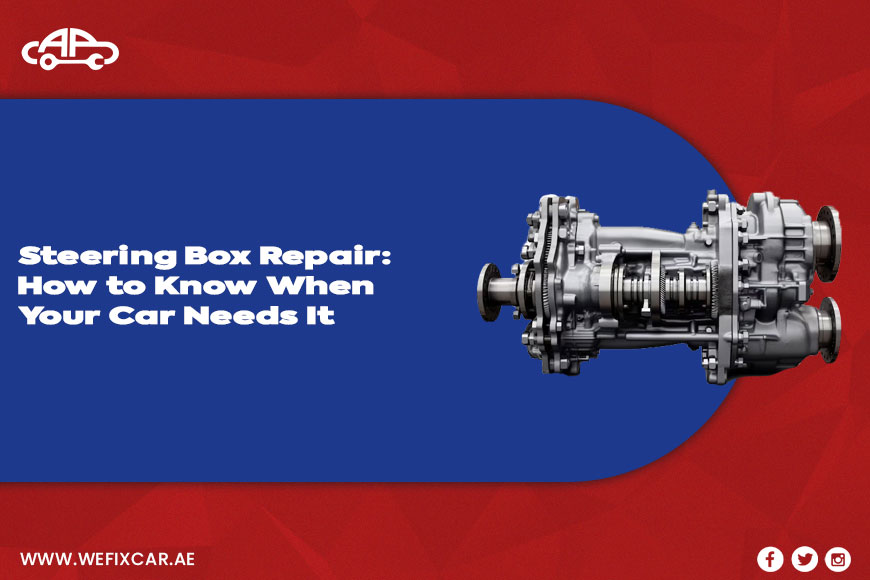Introduction: Why Steering Box Repair Matters
The steering system is one of the most important components of your vehicle, ensuring safe handling, stability, and control. When the steering box starts to fail, you may notice unusual vibrations, difficulty in steering, or noises while turning. Ignoring these signs can lead to dangerous driving conditions and costly repairs.
In this detailed guide, we’ll explain what a steering box is, how it works, the symptoms of a bad steering box, and when you should consider a steering box repair or replacement. We’ll also cover repair costs, maintenance tips, and the benefits of early diagnosis.
What Is a Steering Box and How Does It Work?
The steering box is part of the steering system that translates the rotational motion of the steering wheel into the linear motion required to turn the wheels. It also provides mechanical advantage, making it easier to control the vehicle.
There are two main types of steering boxes:
- Recirculating Ball Steering Box – Common in older cars and heavy vehicles. Uses ball bearings to reduce friction and transfer motion.
- Rack and Pinion Steering Box – More common in modern vehicles. Uses a gear set that directly converts steering wheel motion into wheel movement.
Both systems require lubrication and proper alignment to function smoothly. Without regular steering maintenance, the system can wear out and require repair or replacement.
Common Symptoms of a Bad Steering Box
A failing steering box shows clear warning signs. If you experience any of the following, it’s time to consider a steering box repair:
- Loose Steering Wheel
- If the steering wheel feels loose or has excessive play, it could mean internal components of the steering box are worn out.
- If the steering wheel feels loose or has excessive play, it could mean internal components of the steering box are worn out.
- Steering Wheel Vibration
- Continuous vibration, especially when turning, often signals problems inside the steering box.
- Continuous vibration, especially when turning, often signals problems inside the steering box.
- Difficulty in Steering
- Increased resistance or stiffness while turning may indicate damage to the steering box or power steering system.
- Increased resistance or stiffness while turning may indicate damage to the steering box or power steering system.
- Strange Noises
- Clunking or grinding noises when turning the wheel usually mean the steering box gears are worn or misaligned.
- Clunking or grinding noises when turning the wheel usually mean the steering box gears are worn or misaligned.
- Vehicle Pulling to One Side
- If your car drifts to one side even when the steering wheel is centered, the steering box may be out of adjustment.
- If your car drifts to one side even when the steering wheel is centered, the steering box may be out of adjustment.
- Fluid Leaks (in power steering)
- If the steering box is leaking power steering fluid, you may notice low fluid levels, making steering harder.
- If the steering box is leaking power steering fluid, you may notice low fluid levels, making steering harder.
Causes of Steering Box Problems
Several factors can lead to steering box issues:
- Lack of Lubrication – Dry or worn-out gears can cause friction and wear.
- Normal Wear and Tear – Over time, steering components naturally degrade.
- Improper Steering Box Adjustment – Loose adjustments can cause steering play.
- Power Steering Issues – A faulty pump or low fluid can damage the steering box.
- Driving on Rough Roads – Constant bumps and impacts accelerate steering system wear.
Steering Box Repair vs. Replacement
When faced with steering problems, you need to decide whether to repair or replace the steering box.
- Steering Box Repair
- Suitable for minor issues like leaks, small adjustments, or replacing seals.
- Cost-effective if detected early.
- Suitable for minor issues like leaks, small adjustments, or replacing seals.
- Steering Box Replacement
- Needed when internal gears are damaged, or if the box is cracked or severely worn.
- More expensive but ensures long-term reliability.
- Needed when internal gears are damaged, or if the box is cracked or severely worn.
Tip: Always get a steering system inspection before deciding, as professional mechanics can determine the best option.
Cost of Steering Box Repair
The cost of steering box repair varies depending on your car model, severity of the issue, and labor charges.
- Minor Repair (seal replacement, adjustment): $150 – $300
- Steering Box Rebuild: $400 – $700
- Full Replacement: $800 – $1500+
Luxury vehicles, SUVs, or heavy-duty trucks may cost more due to larger steering systems.
How to Diagnose Steering Box Issues at Home
While professional diagnosis is always recommended, you can check for steering issues at home:
- Park the car on a flat surface.
- Gently move the steering wheel left and right. If there’s excessive play, it’s a bad sign.
- Check for power steering fluid leaks under the vehicle.
- Listen for clunking noises when turning.
- Observe if the car pulls to one side during straight driving.
If any of these symptoms occur, book a steering repair service immediately.
Benefits of Timely Steering Box Repair
- Improved Safety – Better handling and control reduce accident risk.
- Lower Repair Costs – Early fixes prevent expensive replacements.
- Smoother Driving – No more stiffness, vibration, or strange noises.
- Longer Vehicle Life – Proper maintenance reduces wear on other components.
Tips for Steering System Maintenance
To avoid costly steering box replacement, follow these maintenance tips:
- Regularly check and top up power steering fluid.
- Get wheel alignment checked every 6–12 months.
- Avoid hitting curbs or potholes at high speed.
- Schedule routine steering system inspections.
- Lubricate steering components where required.
When to Visit a Mechanic?
If you notice:
- Steering wheel play,
- Grinding noises,
- Leaks, or
- Difficulty in turning,
don’t delay. Visit a reliable car garage in Dubai or your local auto repair shop to prevent further damage. A certified mechanic can provide a professional steering box repair or replacement service.
Read More: Save Time and Money: Secrets to Locating the Best Garage Near Me
Conclusion
Your vehicle’s steering system plays a critical role in road safety. Ignoring steering box problems can lead to dangerous driving conditions, higher costs, and even accidents. By paying attention to early symptoms like steering wheel vibration, loose steering, or fluid leaks, you can address the issue in time.
Whether you need a simple steering box repair or a complete replacement, professional service ensures your car remains safe, smooth, and reliable. If you’re experiencing any of the signs mentioned in this guide, book a steering inspection today and restore confidence in your driving.
FAQs About Steering Box Repair
Q1: What is the most common symptom of a bad steering box?
The most common symptom is a loose or unresponsive steering wheel, often accompanied by vibrations or noises while turning.
Q2: Can I drive with a bad steering box?
It’s not safe. Driving with a damaged steering box increases the risk of losing control of your vehicle.
Q3: How often should I service my steering system?
Ideally, get your steering system checked every 20,000 km or once a year.
Q4: Is steering box repair expensive?
Minor repairs are affordable, but full replacements can be costly, especially for luxury vehicles.
Q5: Can steering problems affect tire wear?
Yes, a faulty steering box or misalignment can cause uneven tire wear.
Q6: How long does a steering box last?
With proper maintenance, a steering box can last up to 100,000–150,000 km.Q7: Can I repair the steering box myself?
Basic checks are possible, but professional repair is recommended for safety.



